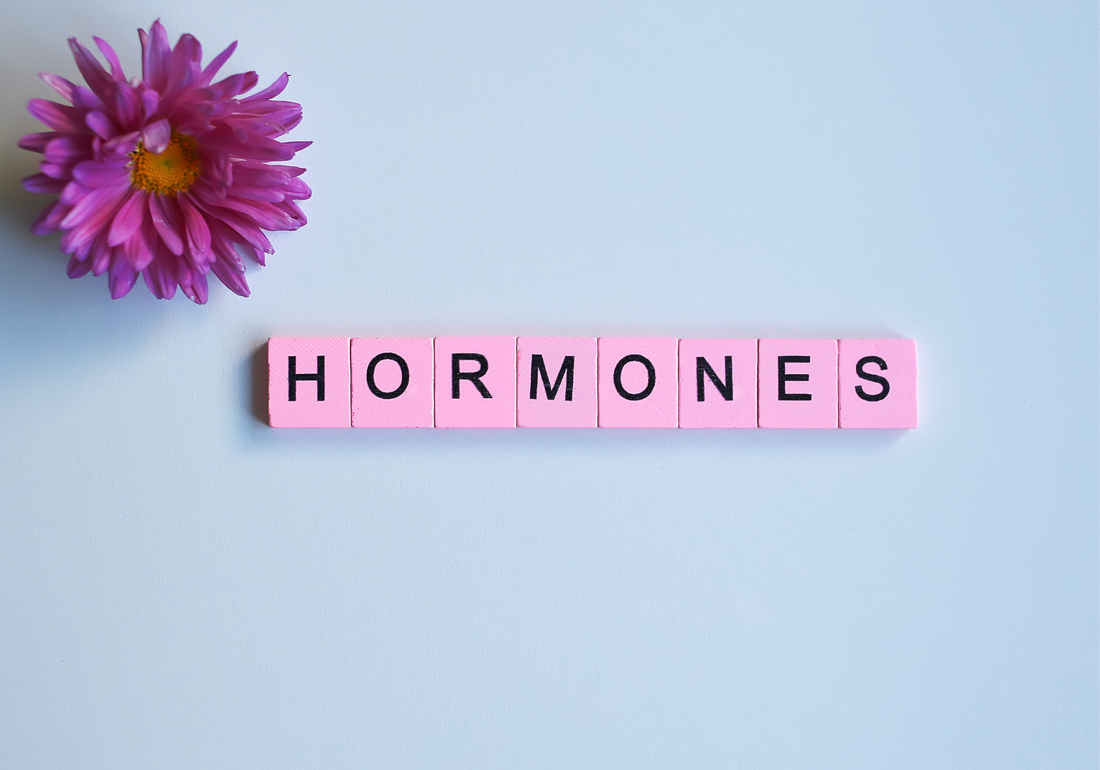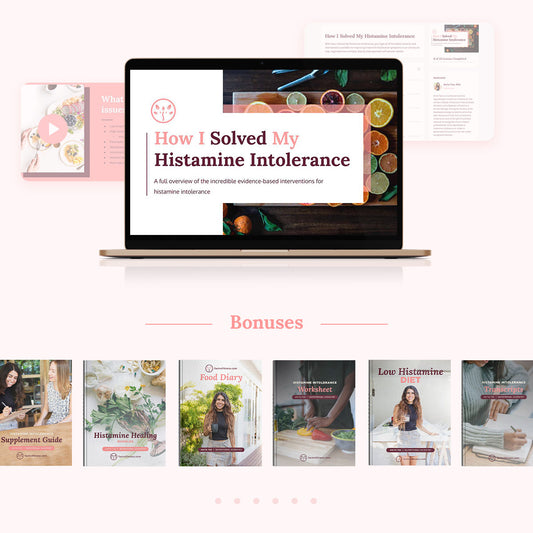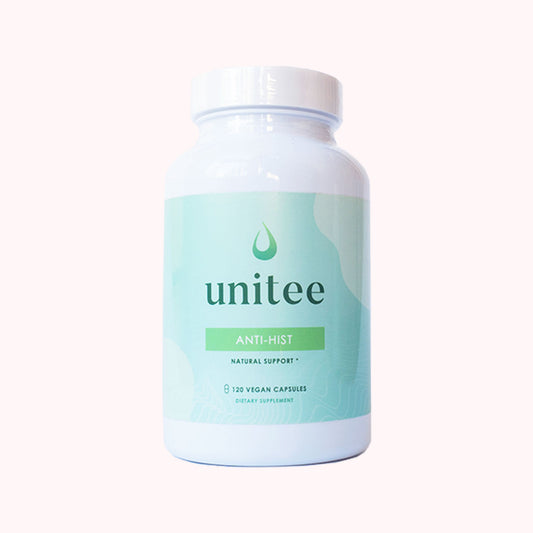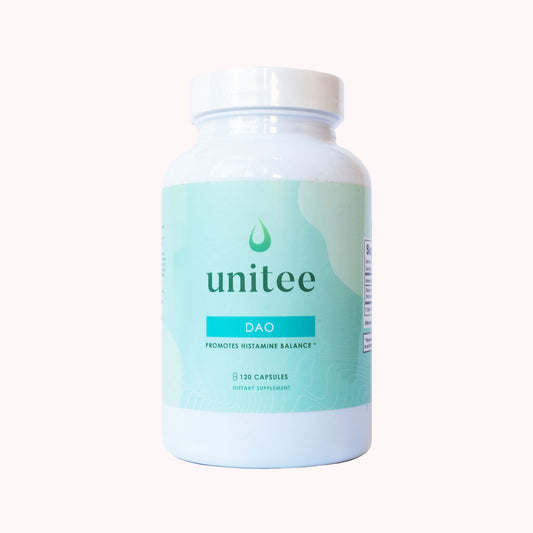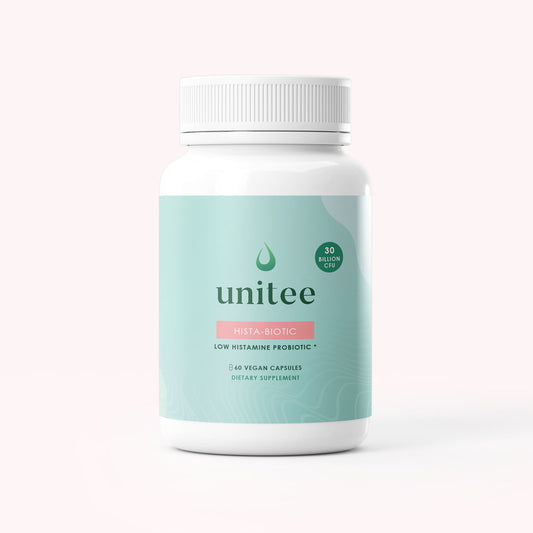Did you know that women are more likely to be histamine intolerant? Well, today we're going to get into the fascinating link between the role that hormones play in those born with a uterus and the development of histamine intolerance.
As a woman, we have estrogen to thank for our feminine characteristics. It’s the hormone that gives us our figure, our softer voice and allows us to have a family. Estrogen is so much more than that. It's an important part of a woman’s health and function, contributing to healthy skin, strong bones, cardiovascular health, regulation of blood and cholesterol levels as well as brain function. The impact that estrogen has on health shows just how severe the consequences can be when there are estrogen imbalances, and the serious impact it can have on your overall well being.
Both low and high estrogen levels can have profound and far-reaching effects, but it’s excess estrogen and its link to histamine intolerance that we want to discuss today.
This link is so interesting, and it explains why more women than men suffer with this debilitating condition...
Histamine Intolerance and Hormones Dysregulation: Is It a Case of Too Much Estrogen?
Often, we think of estrogen excess as being a condition in which the body makes too much of the hormone. While this can be true for younger women who are still in their reproductive years, with fully functioning ovaries, there is, however, another reason estrogen levels may increase. No matter where the estrogen is coming from, for example, from the conversion in fatty tissue as you get older, estrogen levels can also build as a result of inefficient estrogen clearance.
If the body does not process estrogen effectively enough, and is not able to metabolize it to be eliminated as waste once it has been used, levels will rise. Rising estrogen is no fun! It produces those oh-so-familiar symptoms of estrogen imbalance.
If you’ve ever felt cranky, bloated, tired and your breasts hurt a couple of days before you begin your menstrual cycle, this is what I’m talking about. These symptoms are as a result of a surge in estrogen production just before you start your period.
Now, imagine what happens when your estrogen levels don’t drop down like they’re supposed to. These yucky PMS-like symptoms don’t go away! They stick around and leave you constantly feeling this way.
By now you must be wondering: what does this all have to do with histamine?
Start Your Low Histamine Diet!
Estrogen May Affect Histamine Clearance Leading to Histamine Intolerance
You're well aware of the fact that estrogen is a hormone. But so is histamine. Or should I say, very similar to a hormone.
You see, the class of compounds that histamine belongs to are called amines, and when histamine was first discovered, scientists called histamine a local hormone because it was made and acted greatly in the area it was produced. It's not recognized more as a neurotransmitter, or a chemical messenger compound, but it can still be thought of as a type of hormone.
Histamine, just like estrogen, binds to specific receptors throughout the body to produce a response, which tells the body systems to do something.
Histamine receptors are denoted by H1-H4, which are spread throughout the body (1,2). H1 is the most widely distributed throughout the body, with H2 and H3 having more specific locations, and H4 being the most recently discovered and the functionality of it still under investigation.
The histamine-estrogen connection is linked to the H1 receptor.
Get this: estrogen binds to it, just like histamine does (3).
There’s more: estrogen also promotes the release of histamine from some of your immune cells, called mast cells. They are the cells that carry histamine around to wherever the immune system tells them to go, to the site of the body where there’s a possible attack by a foreign invader (4).
These mast cells, distributed all across the body, are also located in the uterus and ovaries. Where do you think estrogen mainly comes from? Exactly! The ovaries.
Because of the cyclical changes that take place in the uterus and ovaries, both estrogen and histamine are constantly being released. And with both the ovaries and uterus being rich in estrogen and histamine receptors, there's an interplay between the binding of estrogen to its receptors, estrogen binding to the H1 receptor, and then histamine also being released by mast cells and binding to its receptors (5). As histamine increases in these locations, it's not only pain and swelling that takes place. Histamine also stimulates more estrogen to be released, creating a vicious cycle of chronically high estrogen and an increase in histamine levels.
Estrogen also has an indirect effect on histamine levels. Estrogen has an impact on one of the most important enzymes the body uses to degrade and break down histamine, called diamine oxidase (DAO) (6). Estrogen hampers the body’s ability to make the enzyme, which causes the levels of DAO to diminish. It means even normal amounts of histamine are ineffectively taken care of, with the supply of DAO not meeting the demands of histamine, which leads to increased histamine levels. In those with already poorly controlled histamine, this effect of estrogen on DAO can send levels - and symptoms - soaring.
When combined, these reasons are why histamine intolerance symptoms may spike around the time of ovulation as well as around the week before your period begins where estrogen levels spike.
PMS, Pregnancy and Progesterone: The Challenges of Histamine Intolerance
It's also important to consider the factors contributing to period pain, heavy periods, headaches, mood swings and other symptoms of PMS outside of the changes your experience in your estrogen and progesterone levels throughout your menstrual cycle. And you guessed it! Histamine plays a role. Mast cell degranulation and histamine release are also culprits leading to these 'typical' cyclical symptoms, which can be exacerbated in those with histamine intolerance (7).
Another intriguing finding in this regard is the change in the symptoms of histamine intolerance throughout pregnancy. Many women have a significant reduction in their symptoms like hives, runny nose, itchy eyes, etc. Some even report having recovered from their asthma once they fell pregnant. It’s because the placenta, which maintains the nutrient supply to the fetus throughout pregnancy, makes a huge amount of DAO. As you well know, this is the enzyme that breaks down histamine and reduces the histamine levels that the body has to deal with (8, 9). During pregnancy, the higher production of DAO by the placenta acts as a protective mechanism, as high histamine levels may be associated with failed pregnancies and miscarriage. In fact, there's evidence to suggest that many women develop allergic-like symptoms prior to a miscarriage as a result of failure in the supply of DAO (10).
Now, one of the best ways to figure out whether your body either needs help to process estrogen more effectively, or reduce the production, is to have your hormone levels checked. This check typically would include measuring your progesterone levels, as progesterone promotes the production of DAO. Naturally, inefficient levels of progesterone would greatly impact DAO supply, and contribute to further problems associated with histamine intolerance.
Of course, it would be great if you could test your histamine levels. Unfortunately, because of the nature of histamine and its affinity to bind to its receptors rather than staying as a free compound in the blood, testing its levels in the blood is not an accurate depiction of what is actually going on. Blood histamine levels are simply not a highly reliable indication of how much you actually have in your system, or what its actually doing (11).
Due to this lack of clarity in testing, I've created an at-home test for histamine intolerance that can be coupled with the hormonal testing mentioned above as more of an indication as to whether your histamine intolerance is being compounded or even caused by hormonal imbalances.
Additionally, since histamine intolerance symptoms are closely linked to the ingestion of high histamine foods, keeping a food and symptom diary is another great way to determine whether histamine is affecting you or not.
But - back to hormones!
For both estrogen and histamine, there are steps you can take to manage their levels in your body.
Start Your Low Histamine Diet!
There’s a Natural Way You Can Balance Both Estrogen and Histamine
Diet is one of the most effective ways to manage histamine intolerance (12). Not surprisingly managing your histamine intake through your diet also plays a role in estrogen balance. The most important thing to start with is to follow a low histamine diet that eliminates all high histamine, histamine releasing, and inflammatory foods.
In addition to lowering your dietary intake of histamine, these four dietary strategies are an important part of balancing both histamine and hormones:
-
Manage your intake of protein, fat and carbs. Your body needs all of the building blocks it receives from food in the form of amino acids, free fatty acids and glucose molecules to function properly. Too little of any of these macronutrients can reduce the capacity of the immune system to function correctly and also influence how your body makes and processes hormones. Often, the diet is too high in simple carbohydrates and saturated fats, contributing to inflammation, immune dysregulation and hormonal imbalances. A more balanced intake of proteins, fats and carbs can help!
-
Reduce inflammation. Inflammation is the root cause of all chronic diseases, and diet is a major influencer. In terms of histamine, foods that contain high histamine levels, or that liberate histamine within your body, or even block the DAO enzyme should be minimized in the diet. Inflammatory foods like sugar, refined grains and processed foods influence the body’s ability to manage hormone production and processing.
-
Avoid hormones in foods. Just like you should try to reduce your histamine load by reducing your intake of high histamine foods, avoid foods that contain estrogen. Dairy and some animal products contain higher hormone levels. If you choose to have these in your diet, be sure to choose those from organic, pasture-raised sources to minimize the hormonal exposure.
-
Avoid alcohol. In both histamine intolerance and estrogen excess, alcohol is a catalyst that can make each condition worse. Due to the fermentation process required to make alcohol, it's a histamine liberator, but it has also been shown to block the effects of DAO (13). It has also been shown to promote increased estrogen levels in the body (14), so it’s best avoided.
As you can see, histamine intolerance is not just about histamine. Often, there are other body systems that are out of balance, which can increase the load of histamine your body has to deal with. And in the same vein, histamine intolerance can promote dysfunction in other body systems as has been shown with regards to estrogen. And this dysregulation in other body systems may be the reason you're dealing with a variety of symptoms that you've never thought could be associated with histamine.
When you begin to understand what the underlying cause of your body system imbalances is, you can begin to manage them! You’ll soon realize that you can bring about a state of health once again as you'll now have the power to address each as they influence the other, which in this case is the interplay between histamine and estrogen imbalance.
There are additional causes to consider as potential triggers and mediators of histamine intolerance that you may need to address. Read my blog article about those, here.
References
- Gene Database. HRH1 histamine receptor H1, HRH2 histamine receptor. (Homo sapiens (human)] 2018. Viewed 11 August 2018.
- Haas , H L & Panula , P. Histamine receptors. Neuropharmacology. 106(2016)1-2.
- Brandes, L., et al. Evidence that the antiestrogen binding site is a histamine or histamine-like receptor. Biochemical and Biophysical Research Communications. Volume 126, Issue 2, 31 January 1985, Pages 905-910.
- Barcik W, Wawrzniak M, Akkis CA, et al. Immune regulation by histamine and histamine-secreting bacteria. Curr Opin Immunol 2017;48:108-113.
- De Leo, B., et al. Immunoprofiling of human uterine mast cells identifies three phenotypes and expression of ERβ and glucocorticoid receptor. F1000Research 2017. https://www.semanticscholar.org/paper/Immunoprofiling-of-human-uterine-mast-cells-three-Leo-Esnal Zufiaurre/c1494299212c94f02c8c36d21b9703012fcc35bb
- Maintz L, Novak N. Histamine and histamine intolerance. Am J Clin Nutr 2007;85(5):1185-1196.
- Tsuji, S., et al. Increased mast cells in endocervical smears of women with dysmenorrhea. Cytojournal. 2018; 15: 27.
- Obed, B., et al. (2017) Elevated histamine model: a protocol for an ex vivo model for in vitro study of histamine effect on placenta. Protocols.io.
- Whittaker, N., et al. Diamine Oxidase Deficiency as a Proposed Mechanism for Anaphylaxis After the Third Stage of Labor: A Case Report [2B]. Obstetrics & Gynaecology. May 2017 - Volume 129 - Issue 5.
- Maintz, L., Schwarzer, V., Bieber, T., van der Ven, K., & Novak, N. (2008). Effects of histamine and diamine oxidase activities on pregnancy: A critical review. Human Reproduction Update, 14(5), 485–495. https://doi.org/10.1093/humupd/dmn014
- Kovacova-Hanuskova, E., et al. Histamine, histamine intoxication and intolerance. Allergologia et Immunopathologia. Volume 43, Issue 5, September–October 2015, Pages 498-506.
- San Mauro, M., et al. Histamine intolerance and dietary management: A complete review. Allergol Immunopathol (Madr). 2016 Sep-Oct;44(5):475-83.
- Zimatkin SM, Anichtchik OV. Alcohol-histamine interactions. Alcohol Alcohol. 1999;34(2):141-147. doi:10.1093/alcalc/34.2.141
- Frydenberg, H., Flote, V.G., Larsson, I.M. et al. Alcohol consumption, endogenous estrogen and mammographic density among premenopausal women. Breast Cancer Res 17, 103 (2015). https://doi.org/10.1186/s13058-015-0620-1

Anita Tee
My name is Anita Tee. I'm a nutritional scientist who specializes in histamine intolerance. I hold a Master of Science in Personalized Nutrition and a Bachelor of Science in Human Biology and Psychology.
For the past ten years, I have used my experience in nutritional and medical health sciences to create a scientifically backed, natural approach to healthcare that relies 100% on evidence-based research.
As I previously suffered from - and overcame - histamine intolerance, my focus is to increase recognition and expand the available resources and protocols available for resolving this particular disorder. To date, I have helped over 4,000 individuals fully resolve or better manage their histamine intolerance symptoms.

